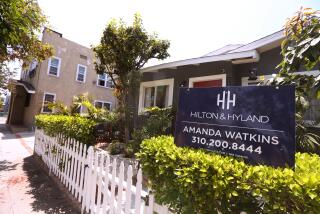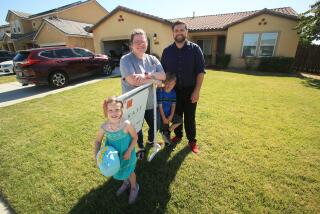A crisis within a crisis
- Share via
The surging tide of housing foreclosures is threatening to sweep away one of the most encouraging, if little noticed, social success stories of the last 15 years.
Starting under President Clinton and continuing under President Bush, African Americans and Latinos made dramatic advances in homeownership from the mid-1990s through the first part of this decade. Those gains stabilized troubled neighborhoods, boosted city treasuries and helped minority families build wealth.
But now that escalator has stopped. From 1995 through 2004, the homeownership rate among African Americans increased every year -- from 43% to just below 50% overall. But since then, the homeownership rate among blacks has fallen back under 48%, according to the Census Bureau. The Latino homeownership rate, which was just 42% in 1995, hit a record 50% in late 2005 but has stagnated since.
Whites are losing ground too. Their homeownership rate has dipped from a peak of 76% in 2004 to about 75% now. But the trend in minority communities is more ominous because their advances were more tenuous. And the problem, for whites and minorities alike, is likely to get worse before it improves. On Tuesday, RealtyTrac reported that in 2007, about 405,000 householders lost their homes, and that the number of borrowers in some stage of foreclosure jumped nearly 80%. As those troubled loans work through the system, 1 million to 2 million more foreclosures may be coming, experts say. “The numbers are going to be dismal, especially in the minority communities, over the next two years,” said Lori Gay, president and chief executive of Los Angeles Neighborhood Housing Services, a nonprofit organization focused on low-income homeownership.
Gay’s group is at the front line of the foreclosure crisis. Every day, it deals with the effect of the rapid, all-but-unregulated growth of the sub-prime lending market in recent years. Sub-prime loans are made by brokers and dealers of sundry ethics and common sense, often to borrowers who might not qualify to borrow as much (or any) money from conventional lenders. Sub-prime loans carry higher interest rates that are typically disguised by deep discounts, low starter interest rates or provisions that initially don’t require the payment of principal or even the full interest.
These loans, which barely existed in the early 1990s, now account for about one-fifth of new mortgages, with African Americans and Latinos more likely to have them than whites. As the discounts have expired, many borrowers have been unable to pay their full obligation. Hence, the rush of foreclosures, which in turn is depressing housing values even for neighbors who are meeting their payments. That decline diminishes their ability to refinance if needed and thus increases their long-term foreclosure risk. This cycle could undo years of progress in revitalizing working-class and inner-city neighborhoods.
There’s plenty of blame to share. Many borrowers were misled, but others were complicit in the carnage. Bruce Solomon, a loan officer at the L.A. housing group, recently worked with an African American man who inherited a home and then lost it to foreclosure after he misrepresented his income and obtained a $570,000 refinancing loan. The lender gave the man a wildly inappropriate loan and winked at his financial forms (because the lender planned to quickly sell the loan to someone else). But the man knowingly borrowed a sum that he could not possibly repay on his real income: $1,000 a month in Social Security benefits. “People got to the point where ... the only thing they wanted to hear was ‘yes,’ ” Solomon said.
In the near term, Gay says, the most pressing need is money for cities to help keep struggling borrowers in their homes -- and to help nonprofit groups committed to community development obtain more of the homes that are lost to foreclosure. Longer term, Washington needs to explore tougher oversight of sub-prime lenders and the creation of a federally backed corporation that would convert troubled adjustable loans into stable 30-year fixed mortgages. Sen. Christopher Dodd (D-Conn.) is sensibly pressing to include help for cities and homeowners in the stimulus plan heading toward Bush’s desk.
A more fundamental change, though, is required to lastingly put more minorities in their own homes. The 1990s’ gains in minority ownership rested on a solid base: increases exceeding 23% in the median income for African Americans and Latinos from 1993 through 2000. Since Bush took office, though, the median income for both groups has fallen. Without consistent income gains, minority homeownership will always teeter on a dangerously fragile foundation.
More to Read
Inside the business of entertainment
The Wide Shot brings you news, analysis and insights on everything from streaming wars to production — and what it all means for the future.
You may occasionally receive promotional content from the Los Angeles Times.










